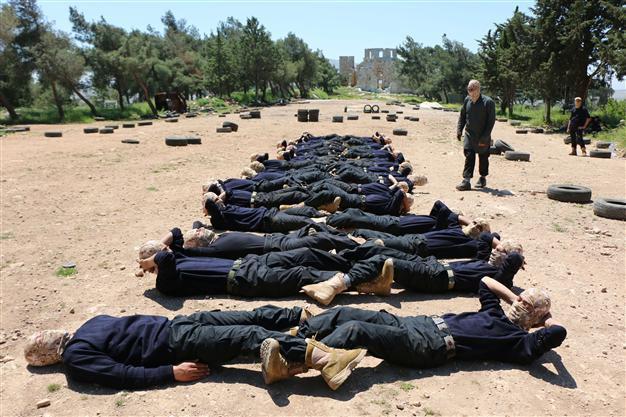Syrian rebels want US support for safe zone
Tolga TANIŞ - WASHINGTON

AFP Photo
Emboldened by recent advances thanks to a more “coordinated” military assistance from regional allies, Syrian rebels have asked for the support of the United States to set up safe zones before the Bashar al-Assad regime collapses.“Damascus should be besieged. Then it could fall suddenly. Before it falls, safe zones should be established to prevent extremists from abusing any subsequent void of power,” said Khaled Khoja, the president of the Syrian National Coalition (SNC), in an interview with daily Hürriyet.
The Syrian opposition envisages safe zones as areas where it can set up a transitional government to serve people under land protection from the Free Syrian Army (FSA) and air protection from international forces.
“This is the concept,” Khoja says, adding that it would serve the purposes of forming a civilian government, paving the way for refugees to return to Syria from abroad, facilitating the humanitarian aid flow, providing a controlled advance toward Damascus, preventing extremists from gaining ground, and limiting the number of daily casualties.
According to Khoja, rebels have been gaining ground throughout the country over the past two months thanks to increased arms deliveries to Turkey-supported FSA units in the north and the Saudi-supported ones in the south.
“Saudi Arabia’s military operation in Yemen revealed that there is a force in the region that can stop Iran’s influence. This force has understood that it should progress in cooperation with Saudi Arabia, Qatar, Jordan and Turkey toward an agreement on Syria,” he added.
‘Joint command’ leads to milestone
Claiming that the war in Syria is now at a “very important milestone,” Khoja said the regime has started to face serious difficulty, despite Russian and Iranian support, because rebels “are now fighting together under a joint command.”
Regime forces were recently dispersed in Daraa, lost Jisr al-Shughour, and retreated from key locations on the highway between Aleppo and Damascus, while their siege on Aleppo is also broken, he also noted.
Meanwhile, Khoja said internal fighting had broken out inside the regime over what stemmed from some Syrian regime generals’ opposition to Iran’s overwhelming influence.
“The collapse of the regime will take us to a scenario that we never want to see. This is because the regime calls up ISIL [the Islamic State of Iraq and the Levant] wherever it retreats,” he said.
The FSA, which had been struggling to find even basic food just months ago, now forces al-Assad to withdraw thanks to increased military assistance, he added. Not only the war in Yemen, but also the change in the Saudi Arabian leadership is a key factor in this, according to Khoja.
“King Salman and his team have always supported coming closer to Turkey. When they came to power, it created a new momentum. [Military] assistance increased as a result,” he said.
The road to Damascus
The rebels now plan to advance toward Damascus, Hama and Homs, while skipping Latakia.
“The important point is besieging and capturing Damascus, before setting up a transitional government there. If that happens, the transition will be just,” Khoja said.
But where in this picture are the extremists other than ISIL, such as the various al-Qaeda-affiliated groups?
“Al-Nusra’s presence is exaggerated,” Khoja said, while also admitting that other Syrian rebels were sometimes in “tactical coordination” with the jihadist group, despite the fact that the SNC has listed it as a terrorist organization.
“If we can set up a civilian government inside safe zones, we will tell al-Nusra that it must disconnect from al-Qaeda and return to a domestic Syrian line of thought. We will still be trying to repulse them as we will keep considering them a threat,” he said.
















